CHEVROLET PRIZM 1998 3.G Repair Manual
Manufacturer: CHEVROLET, Model Year: 1998, Model line: PRIZM, Model: CHEVROLET PRIZM 1998 3.GPages: 364, PDF Size: 18.79 MB
Page 61 of 364
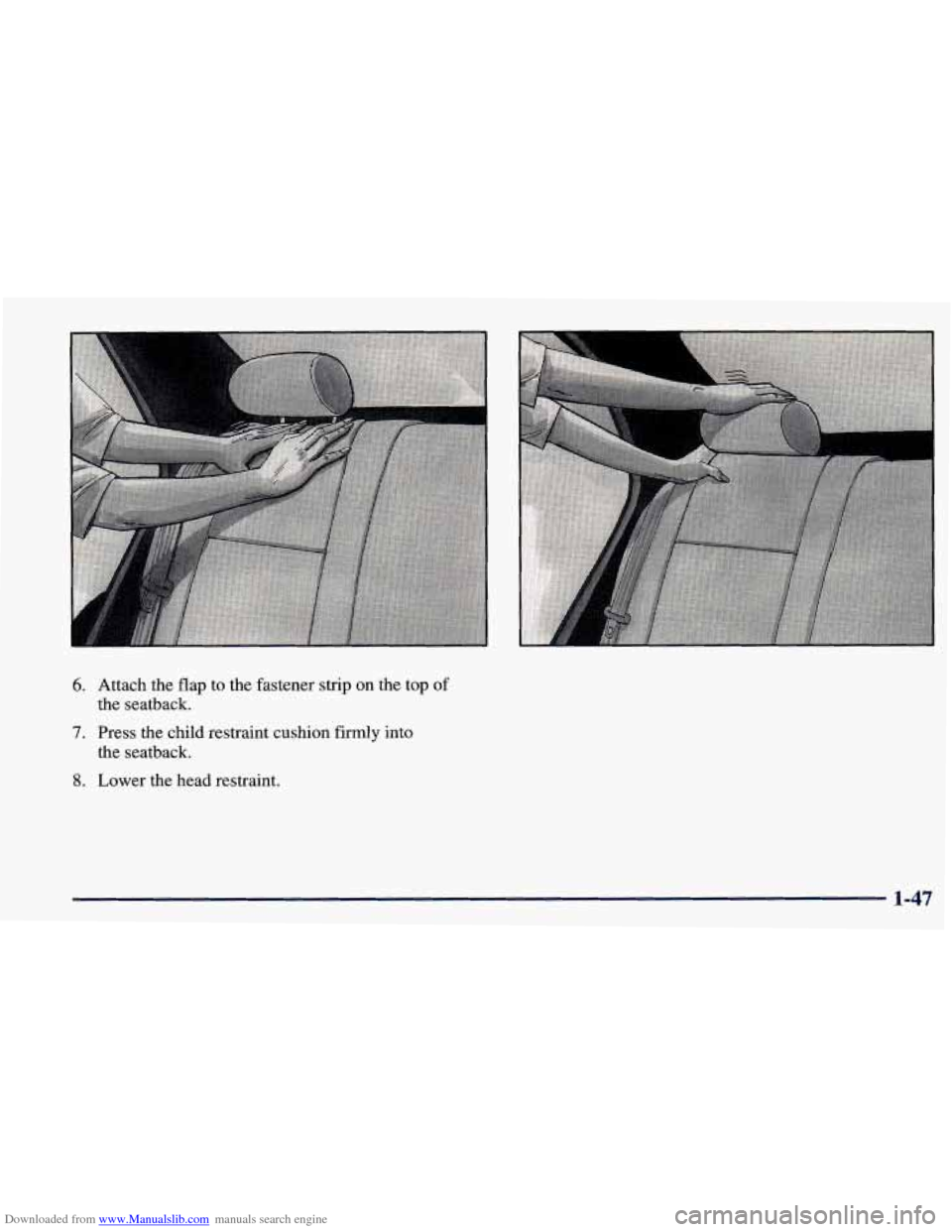
Downloaded from www.Manualslib.com manuals search engine 6. Attach the flap to the fastener strip on the top of
7. Press the child restraint cushion firmly into
the seatback.
the seatback.
8. Lower the head restraint.
1-47
Page 62 of 364
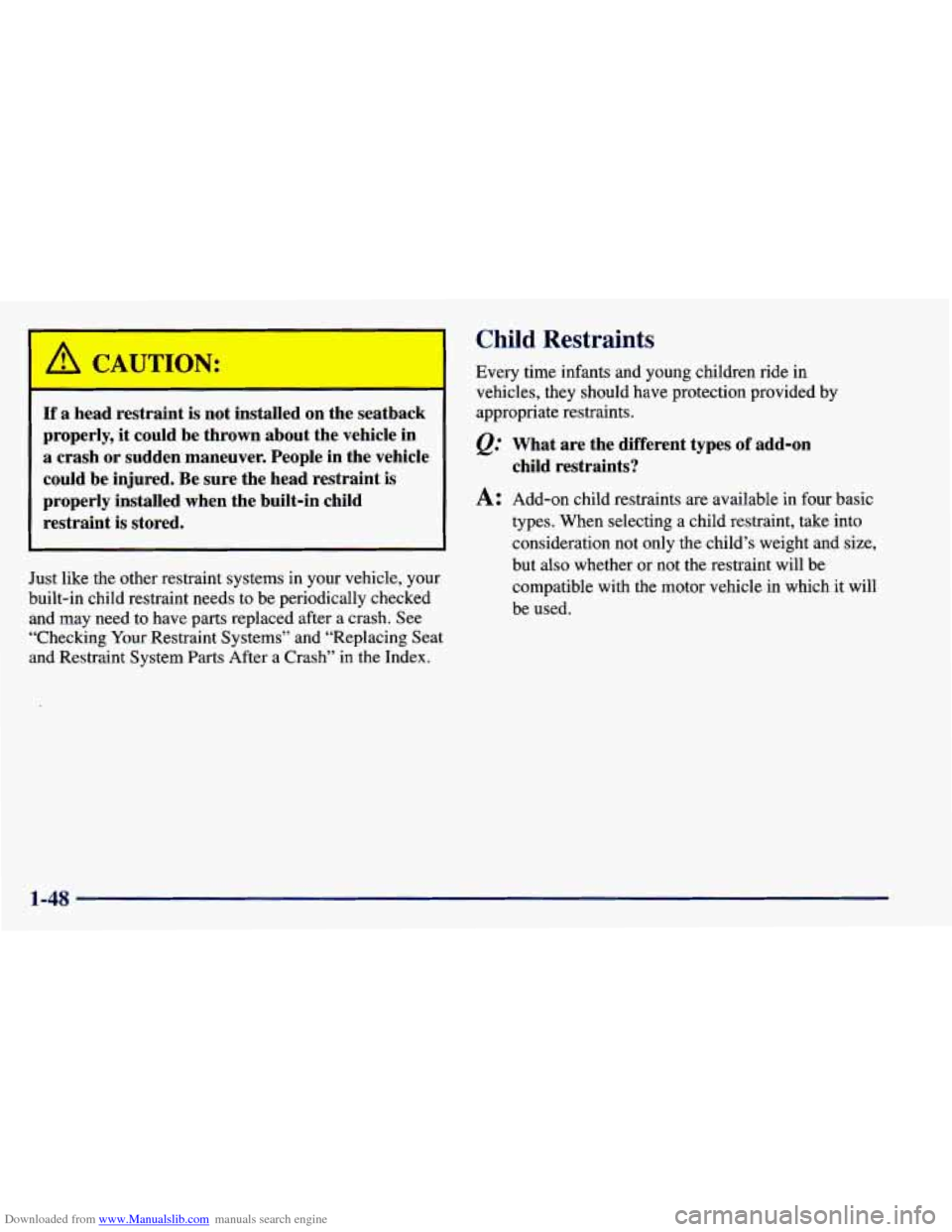
Downloaded from www.Manualslib.com manuals search engine I b, CAUTION:
If a head restraint is not installed on the seatback
properly, it could be thrown about the vehicle in
a crash or sudden maneuver. People in the vehicle
could be injured. Be sure the head restraint is
properly installed when the built-in child
restraint is stored.
Just like the other restraint systems in your vehicle, your
built-in child restraint needs to be periodically checked
and may need to have parts replaced after a crash. See
“Checking Your Restraint Systems’’ and “Replacing Seat
and Restraint System Parts After a Crash” in the Index.
Child Restraints
Every time infants and young children ride in
vehicles, they should have protection provided by
appropriate restraints.
12.’
A:
What are the different types of add-on
child restraints?
Add-on child restraints are available in four basic
types. When selecting a child restraint, take into
consideration not only the child’s weight and size,
but also whether or not the restraint will be
compatible with the motor vehicle in which it will
be used.
1-48
Page 63 of 364
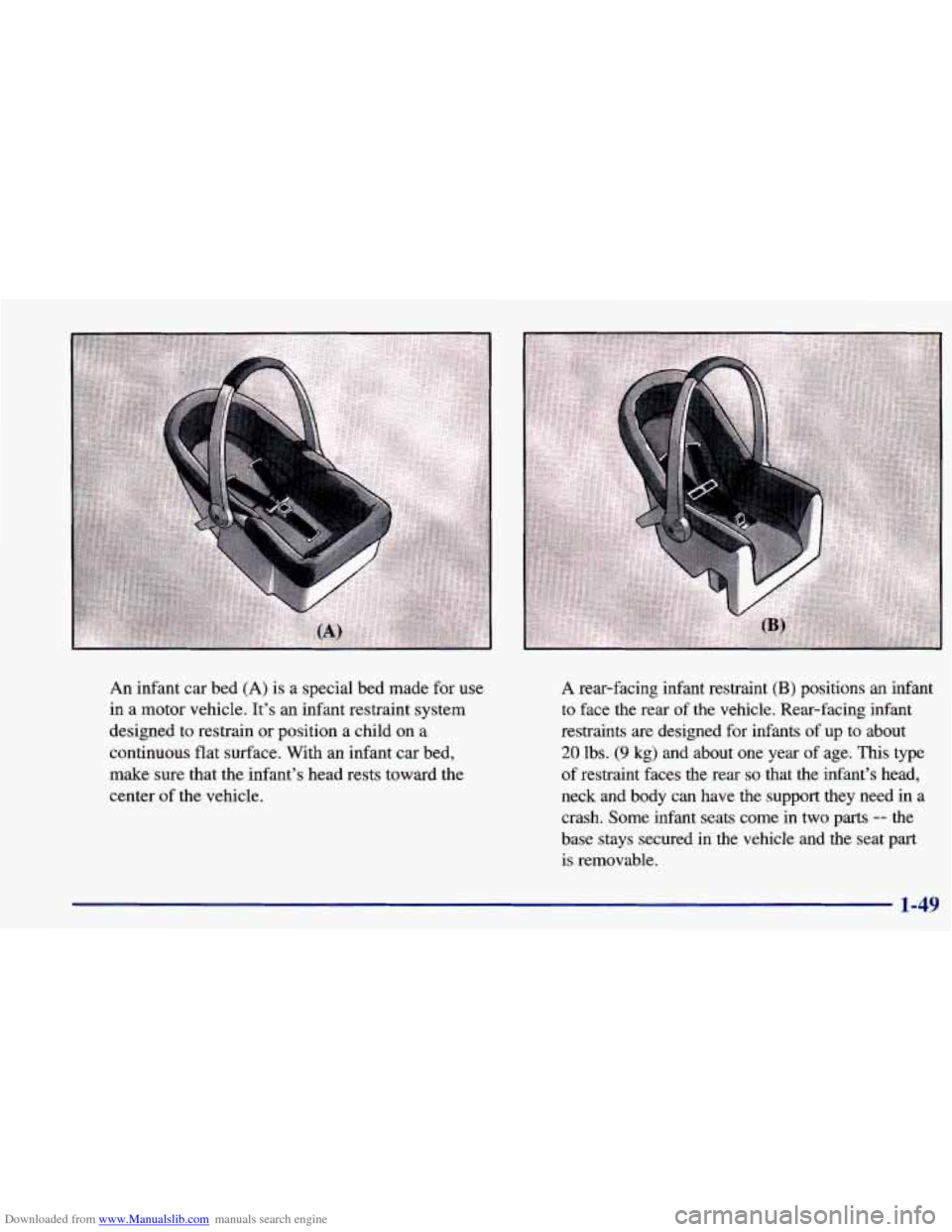
Downloaded from www.Manualslib.com manuals search engine An infant car bed (A) is a special bed made for use
in a motor vehicle. It’s an infant restraint system
designed to restrain or position a child on a
continuous flat surface. With an infant car bed,
make sure that the infant’s head rests toward the
center of the vehicle.
A rear-facing infant restraint (B) positions an infant
to face the rear of the vehicle. Rear-facing infant
restraints
are designed for infants of up to about
20 lbs. (9 kg) and about one year of age. This type
of restraint faces the rear
so that the infant’s head,
neck and body can have the support they need in a crash. Some infant seats come in two
parts -- the
base stays secured in the vehicle and the seat
part
is removable.
1-49
Page 64 of 364
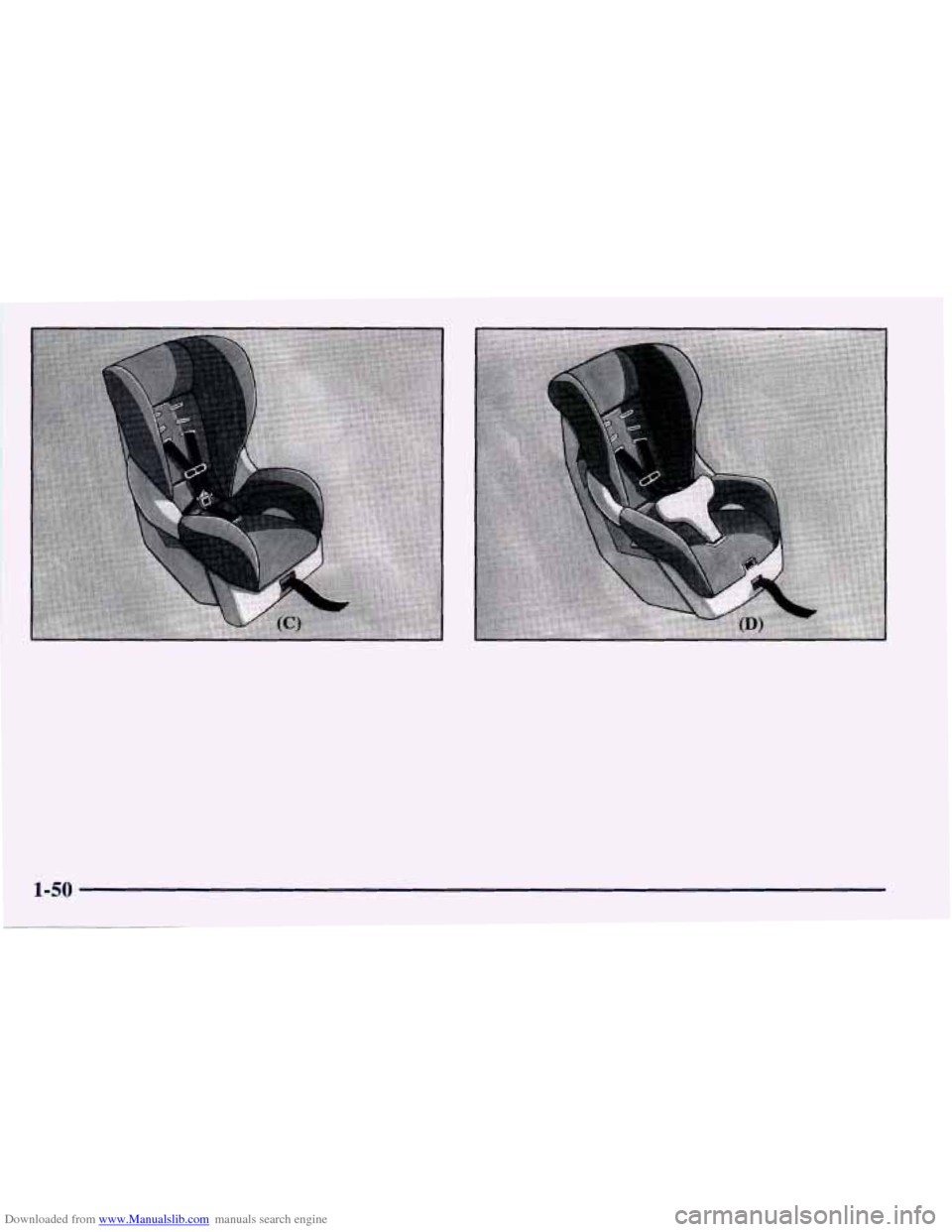
Downloaded from www.Manualslib.com manuals search engine 1-50
Page 65 of 364
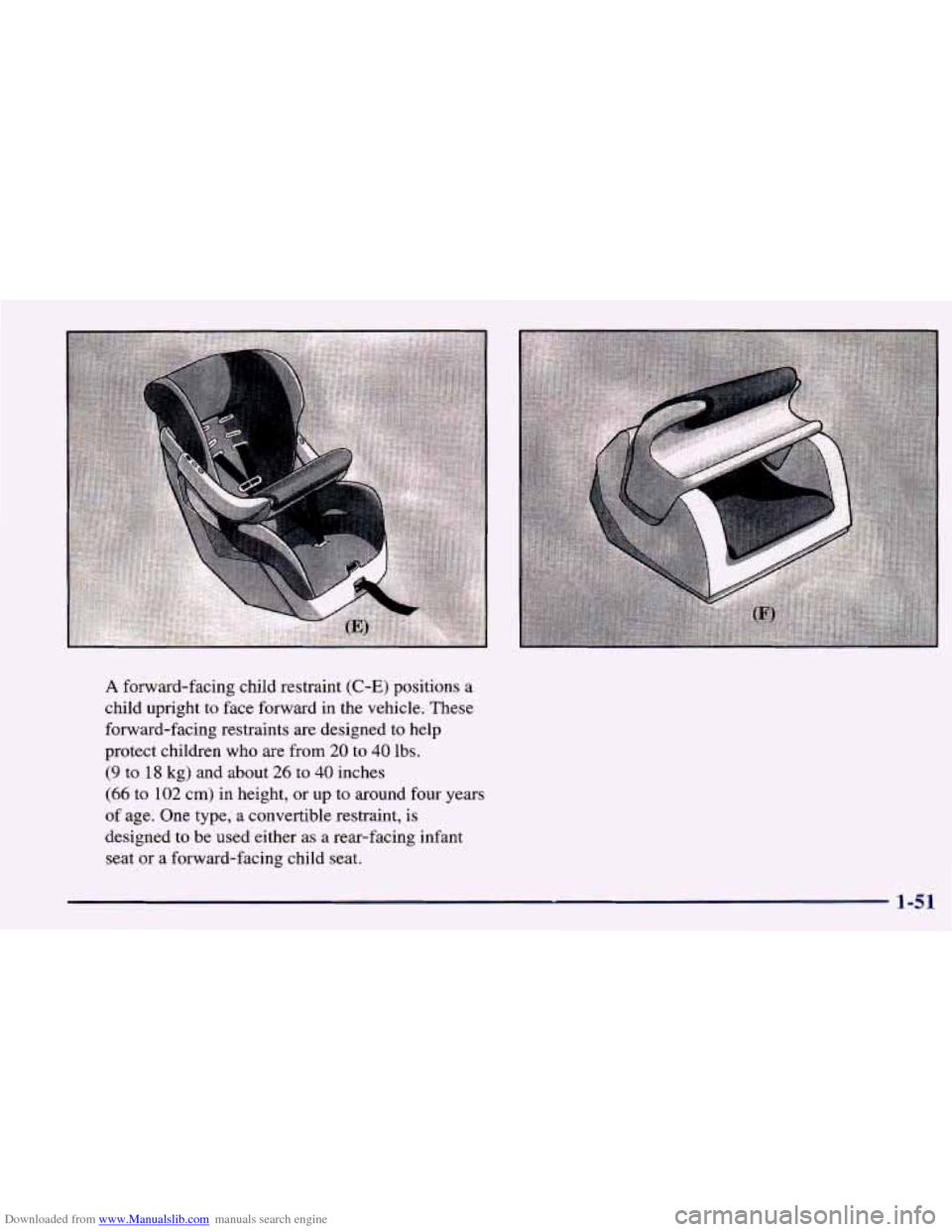
Downloaded from www.Manualslib.com manuals search engine A forward-facing child restraint (C-E) positions a
child upright to face forward in the vehicle. These
forward-facing restraints are designed to help
protect children who are from
20 to 40 lbs.
(9 to 18 kg) and about 26 to 40 inches
(66 to 102 cm) in height, or up to around four years
of age. One type, a convertible restraint, is
designed to be used either as a rear-facing infant
seat or a forward-facing child seat.
1-51
Page 66 of 364
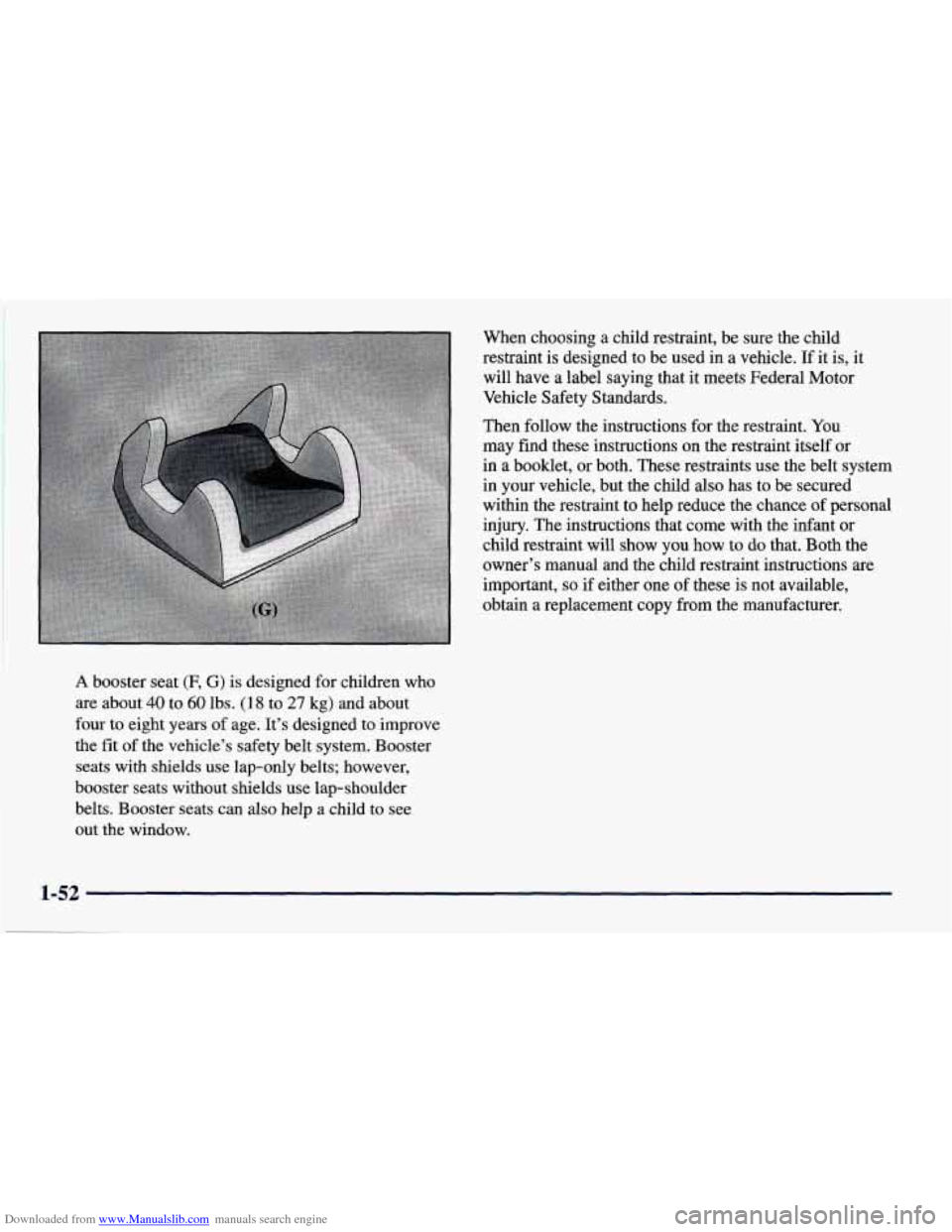
Downloaded from www.Manualslib.com manuals search engine A booster seat (F, G) is designed for children who
are about
40 to 60 lbs. (18 to 27 kg) and about
four to eight years of age. It’s designed to improve
the
fit of the vehicle’s safety belt system. Booster
seats with shields use lap-only belts; however,
booster seats without shields
use lap-shoulder
belts. Booster seats can also help a child to see
out the window. When choosing
a child restraint, be sure the child
restraint is designed to be used in
a vehicle. If it is, it
will have
a label saying that it meets Federal Motor
Vehicle Safety Standards.
Then follow the instructions for the restraint.
You
may find these instructions on the restraint itself or
in a booklet, or both. These restraints use the belt system
in your vehicle, but the child also has to be secured
within the restraint to help reduce the chance of personal
injury. The instructions that come with the infant or
child restraint will show you how
to do that. Both the
owner’s manual and the child restraint instructions are
important,
so if either one of these is not available,
obtain a replacement copy from the manufacturer.
1-52 ~
Page 67 of 364
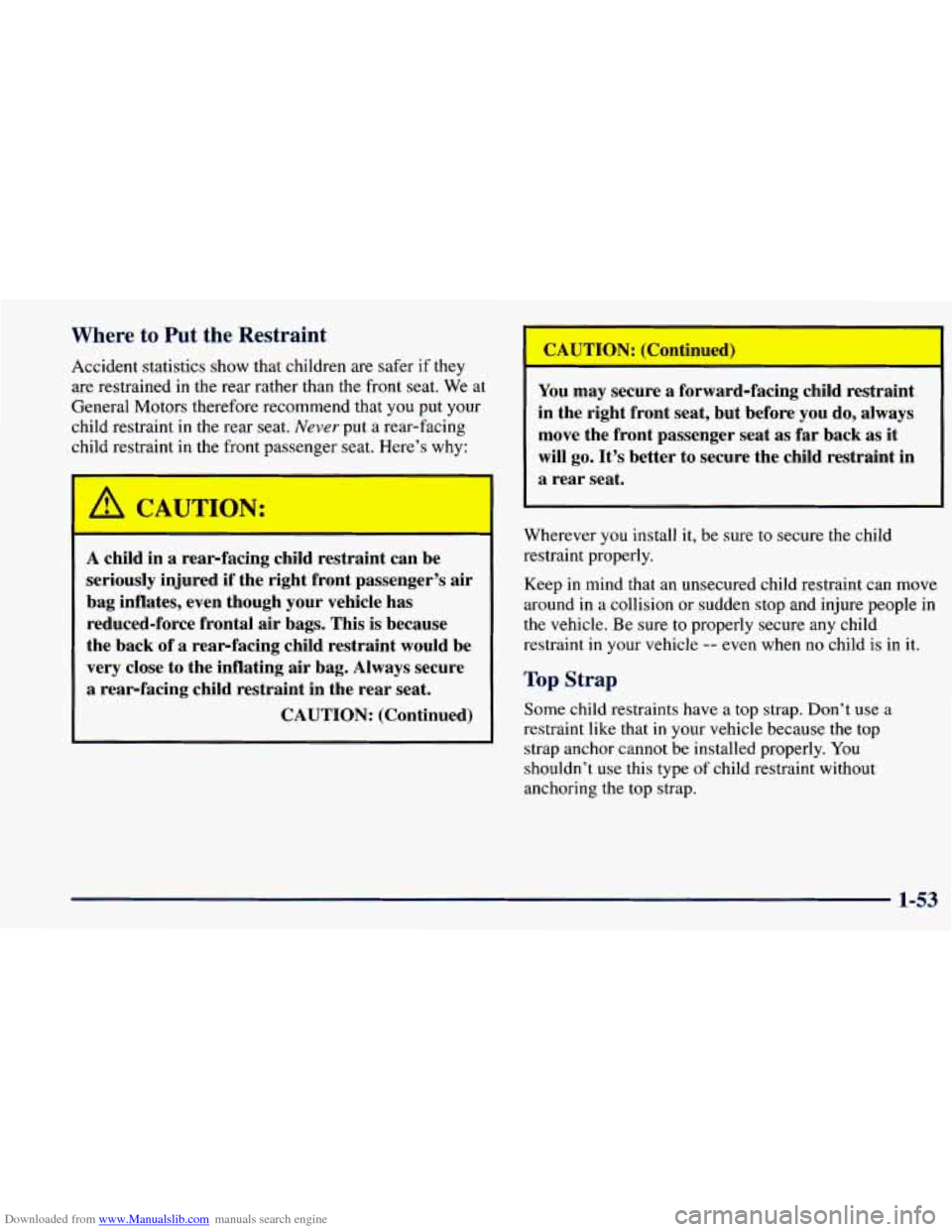
Downloaded from www.Manualslib.com manuals search engine Where to Put the Restraint
Accident statistics show that children are safer if they
are restrained in the rear rather than the front seat. We at
General Motors therefore recommend that you put your
child restraint in the rear seat.
Never put a rear-facing
child restraint in the front passenger seat. Here’s why:
r
A child in a rear-facing child restraint can be
seriously injured if the right front passenger’s air
bag inflates, even though your vehicle has
reduced-force frontal air bags. This is because
the back of
a rear-facing child restraint would be
very close to the inflating air bag. Always secure
a rear-facing child restraint in the rear seat.
CAUTION: (Continued) You
may secure a forward-facing child restraint
in the right front seat, but before you do, always
move the front passenger seat as far back as it
will go. It’s better to secure the child restraint in
a rear seat.
Wherever you install it, be sure to secure the child
restraint properly.
Keep
in mind that an unsecured child restraint can move
around in a collision or sudden stop and injure people in
the vehicle. Be sure to properly secure any child
restraint in your vehicle
-- even when no child is in it.
Top Strap
Some child restraints have a top strap. Don’t use a
restraint like that in your vehicle because the top
strap anchor cannot be installed properly. You
shouldn’t use this type
of child restraint without
anchoring the top strap.
1-53
Page 68 of 364
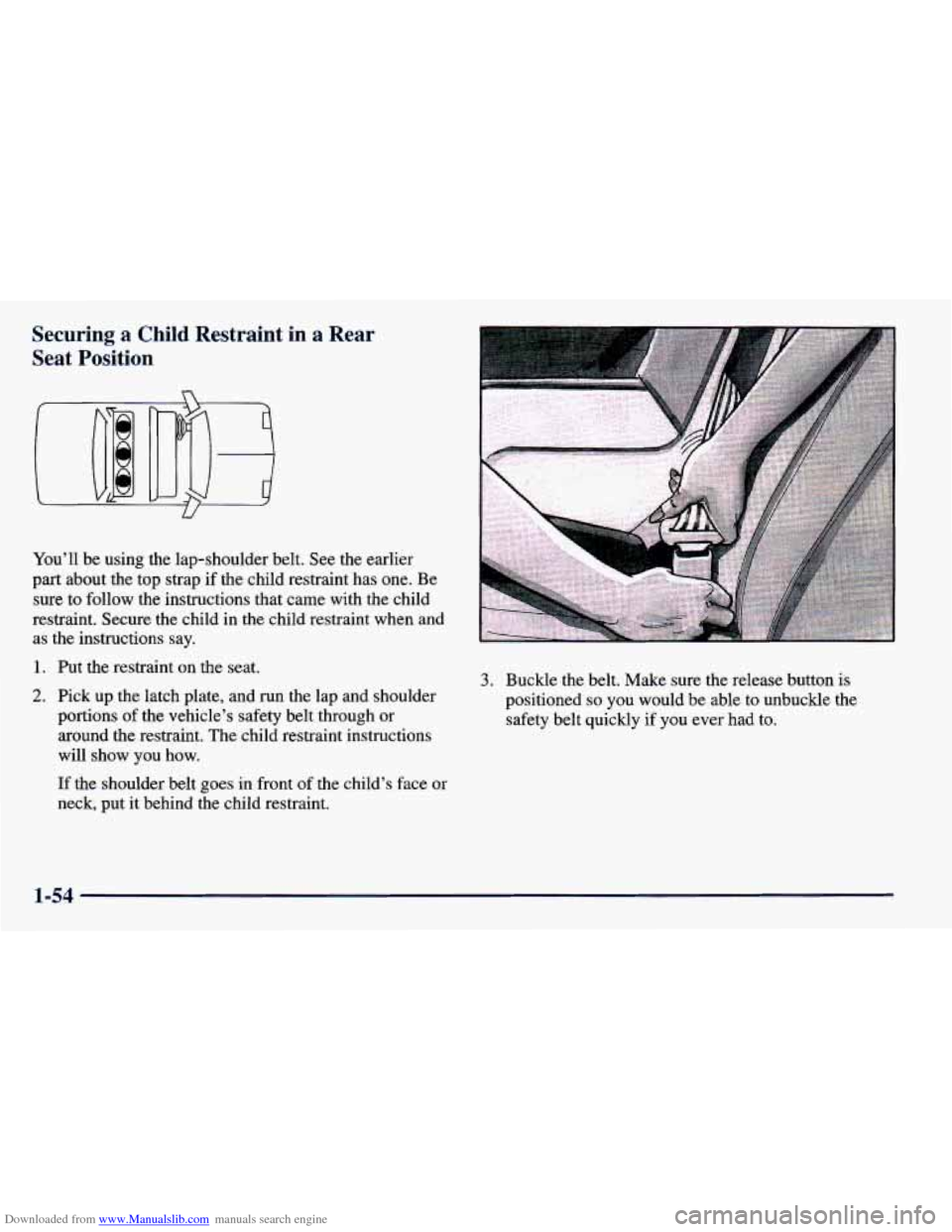
Downloaded from www.Manualslib.com manuals search engine Securing a Child Restraint in a Rear
Seat Position
n
U
You’ll be using the lap-shoulder belt. See the earlier
part about the top strap if the child restraint has one. Be
sure to follow the instructions that came with the child
restraint. Secure the child in
the child restraint when and
as the instructions say.
1. Put the restraint on the seat.
2. Pick up the latch plate, and run the lap and shoulder
portions of the vehicle’s safety belt through or
around the restraint. The child restraint instructions
will show you how.
If the shoulder belt goes in front of the child’s face or
neck, put it behind the child restraint.
3. Buckle the belt. Make sure the release button is
positioned
so you would be able to unbuckle the
safety belt quickly if
you ever had to.
1-54
Page 69 of 364
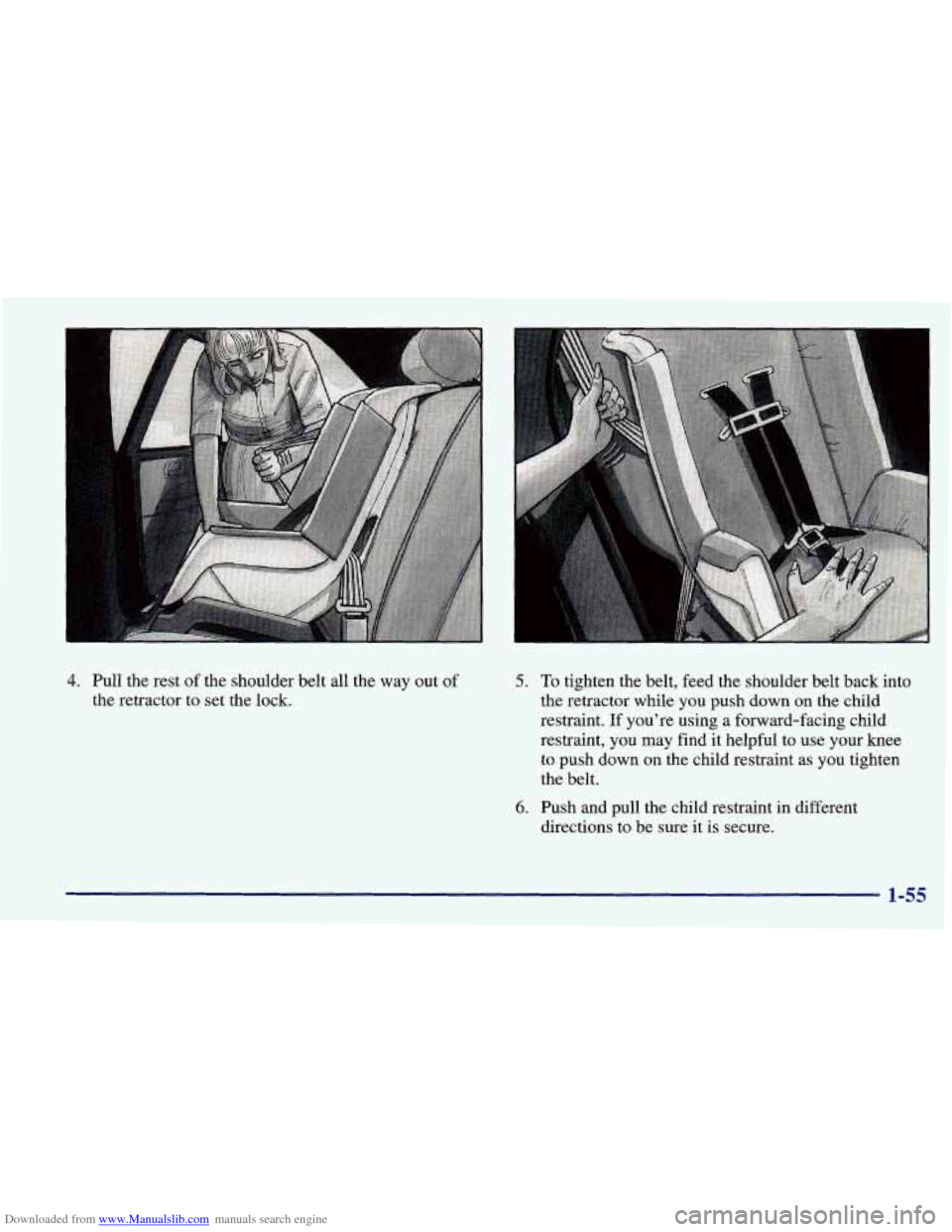
Downloaded from www.Manualslib.com manuals search engine 4. Pull the rest of the shoufder belt all the way out of
the retractor to set the lock. 5.
6.
To tighten the belt, feed the shoulder belt back into
the retractor while
you push down on the child
restraint. If you’re using a forward-facing child
restraint, you may find it helpful to use your knee
to push down on the child restraint as you tighten
the belt.
Push
and pull the child restraint in different
directions to be sure it is secure.
1-55
Page 70 of 364
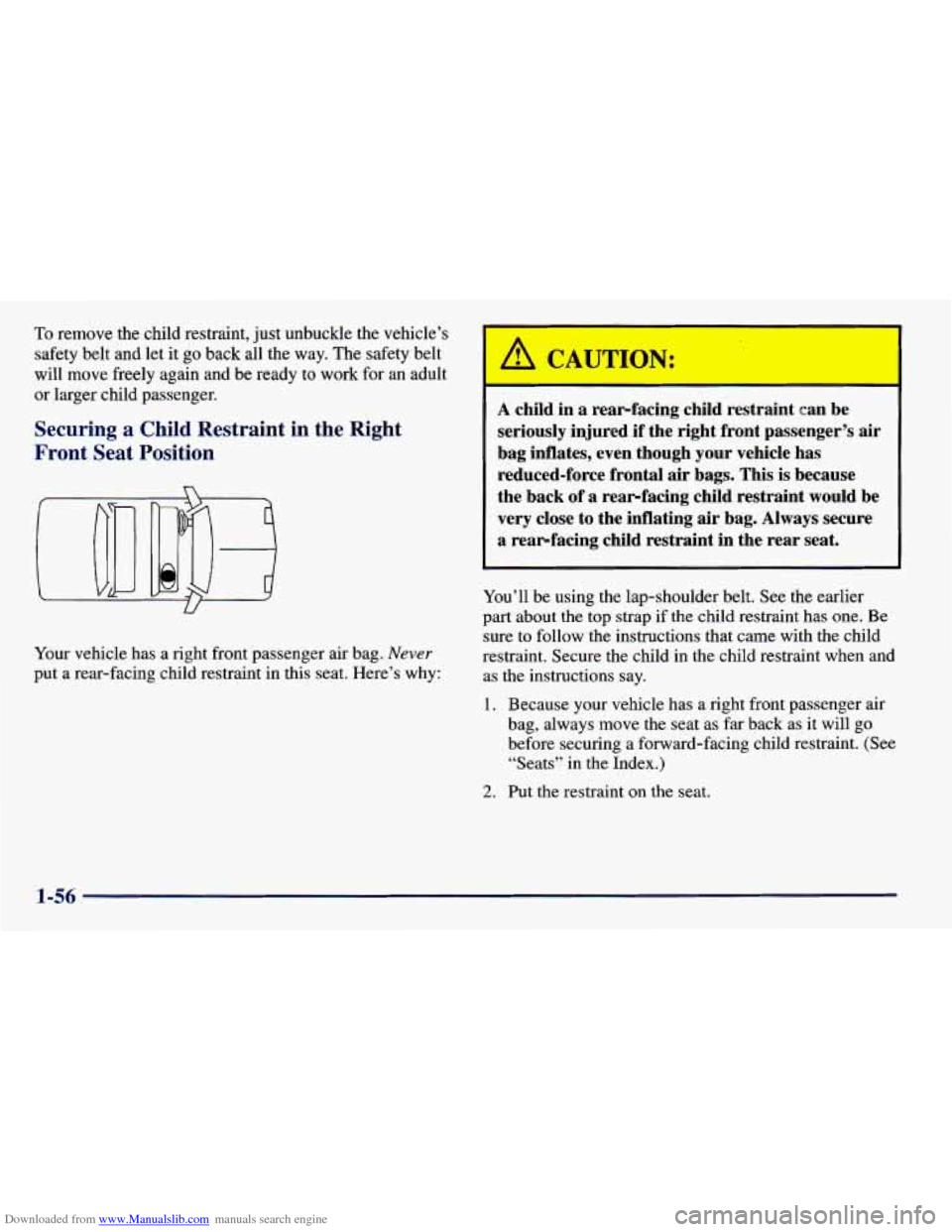
Downloaded from www.Manualslib.com manuals search engine To remove the child restraint, just unbuckle the vehicle’s
safety belt and let it
go back all the way. The safety belt
will move freely again and be ready to work for an adult
or larger child passenger.
Securing a Child Restraint in the Right
Front
Seat Position
Your vehicle has a right front passenger air bag. Never
put a rear-facing child restraint in this seat. Here’s why:
A child in a rearfacing child restraint can be
seriously injured if the right front passenger’s air
bag inflates, even though your vehicle has
reduced-force frontal
air bags. This is because
the back of
a rearfacing child restraint would be
very close to the inflating
air bag. Always secure
a rearfacing child restraint in the rear seat.
You’ll be using the lap-shoulder belt. See the earlier
part about
the top strap if the child restraint has one. Be
sure to follow the instructions that came with the child
restraint. Secure the child in the child restraint when and
as the instructions say.
1. Because your vehicle has a right front passenger air
bag, always move
the seat as far back as it will go
before securing a forward-facing child restraint. (See
“Seats” in the Index.)
2. Put the restraint on the seat.
1-56